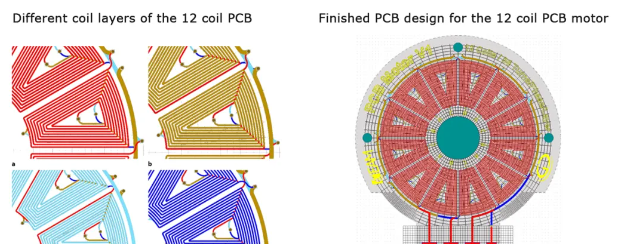PCB motor - a new generation of high-efficiency and compact motor technology analysis
2025-03-24

With the development of precision manufacturing and electronic technology, the motor industry is undergoing a technological revolution. PCB motor (Printed Circuit Board Motor) is becoming an important power solution in the fields of robots, automation equipment, and electric vehicles due to its compactness, high efficiency, and lightweight. This article will provide an in-depth analysis of how PCB motors work, their benefits, and the role of their core component, wedge magnets, and explore their potential for future applications.
What is a PCB Motor?
The PCB motor is a brushless motor based on axial flux design, and its core feature is the use of a printed circuit board (PCB) as the stator, rather than the traditional core winding. The copper foil coils on the PCB stator are manufactured through an etching process, which makes the motor smaller and lighter, while improving production consistency and control accuracy.
PCB motor
Basic composition
Stator (PCB structure):
The amount of copper used in the stator of the PCB motor is 66% less than that of the traditional wound stator, and it is composed of multiple printed circuit boards stacked on top of each other, replacing the traditional copper wire winding and realizing the optimization of the current path.
Rotor (wedge magnet):
A high-performance NdFeB magnet is used to provide a strong magnetic field to drive the stator coil.
Control system:
It is usually used with Hall sensors or non-sensing FOC (Magnetic Field Oriented Control) algorithms to achieve high-precision dynamic control.
PCB motor
How it works
When an electric current flows through a copper foil coil on the PCB stator, a rotating magnetic field is formed inside the motor. The magnetic field acts on the rotor of the wedge-shaped magnet, causing it to rotate in a set direction. Compared with traditional motors, PCB motors use an axial magnetic flux structure to reduce losses in the magnetic flux path, thereby improving motor efficiency.
PCB motor
Application Benefits
The ironless structure of the PCB motor reduces hysteresis and eddy current losses, improves efficiency, and reduces operating noise. At the same time, the risk of insulation damage to the traditional motor windings is eliminated, and the stability of the system is improved.
Lightweight and compact design:
Due to the absence of traditional copper wire windings, the stator thickness and mass of the PCB motor are greatly reduced, which can effectively reduce the overall weight of the equipment. For example, PCB motors use about 66% less copper than conventional motors, making them particularly suitable for lightweight applications such as drones, wearables, and robotic joints.

Better Thermal Stability:
The copper windings, iron cores, and insulating materials in conventional motors have different coefficients of thermal expansion, which are prone to thermal stress when the temperature changes, resulting in cracking of the insulation layer. The stator structure of the PCB motor is the same, and its coefficient of thermal expansion is close, so as to avoid the problem of thermal stress and improve long-term reliability.
High Consistency & Automated Production:
In the production process of traditional motor windings, it is difficult to achieve complete consistency in the density and insulation quality of copper wire winding. The PCB motor adopts a standardized PCB manufacturing process, which can ensure the consistency of the coil path through automated production, reduce production errors, and improve product consistency.
Long service life:
The ironless design of the PCB motor makes it cogging-free, which reduces mechanical friction and increases system life. Generally speaking, the stator of PCB motors has a lifetime of 10 times that of traditional stators, making it especially suitable for high-reliability scenarios, such as precision medical equipment and industrial automation.
Wedge magnets
The role in PCB motors

Magnets are a key component of PCB motors, determining the output torque, power, and efficiency of the motor. Compared with traditional rectangular magnets, wedge-shaped magnets optimize the magnetic field distribution and improve the electromagnetic conversion efficiency of the motor.
The magnet material commonly used in PCB motors is NdFeB (NdFeB), which has high magnetic energy product and excellent temperature stability. Customers can customize the shape and specification of the magnet according to the application needs, such as using segmented bonded magnets to reduce eddy current losses.

Wedge magnets are mainly used in PCB motors. Since tightly packed magnets need to control the cumulative gap and the tightness of the magnet's fit, adaptability is an important factor to consider.
PCB motor
Fields of application
Robot:
For dexterous hands, miniature joints, etc., for more precise control.
Drone:
The ultra-lightweight feature is suitable for aircraft powertrains.
Medical Equipment:
For example, surgical robots and electric prostheses are particularly important for high precision and low noise.
Consumer Electronics:
Smart cameras, VR/AR devices, etc., PCB motors can be used in haptic feedback systems.
With the advantages of lightweight, high efficiency and integration, PCB motors are becoming an emerging power solution for robots, automation, drones, medical equipment and other industries. Combined with the optimized design of the wedge magnet, the PCB motor not only improves the motor performance, but also reduces energy consumption and maintenance costs. With the advancement of manufacturing processes and the development of AI control algorithms, PCB motors are expected to play a central role in more high-end applications.
Previous:
Related Information
Contact Us
E-mail:
tyler@lzworker.com
Telephone:
+86-133-0591-6106
Address:
45 Tonghe Road, Hongxing Farm, Gaishan Town, Cangshan District, Fuzhou City, Fujian Province









